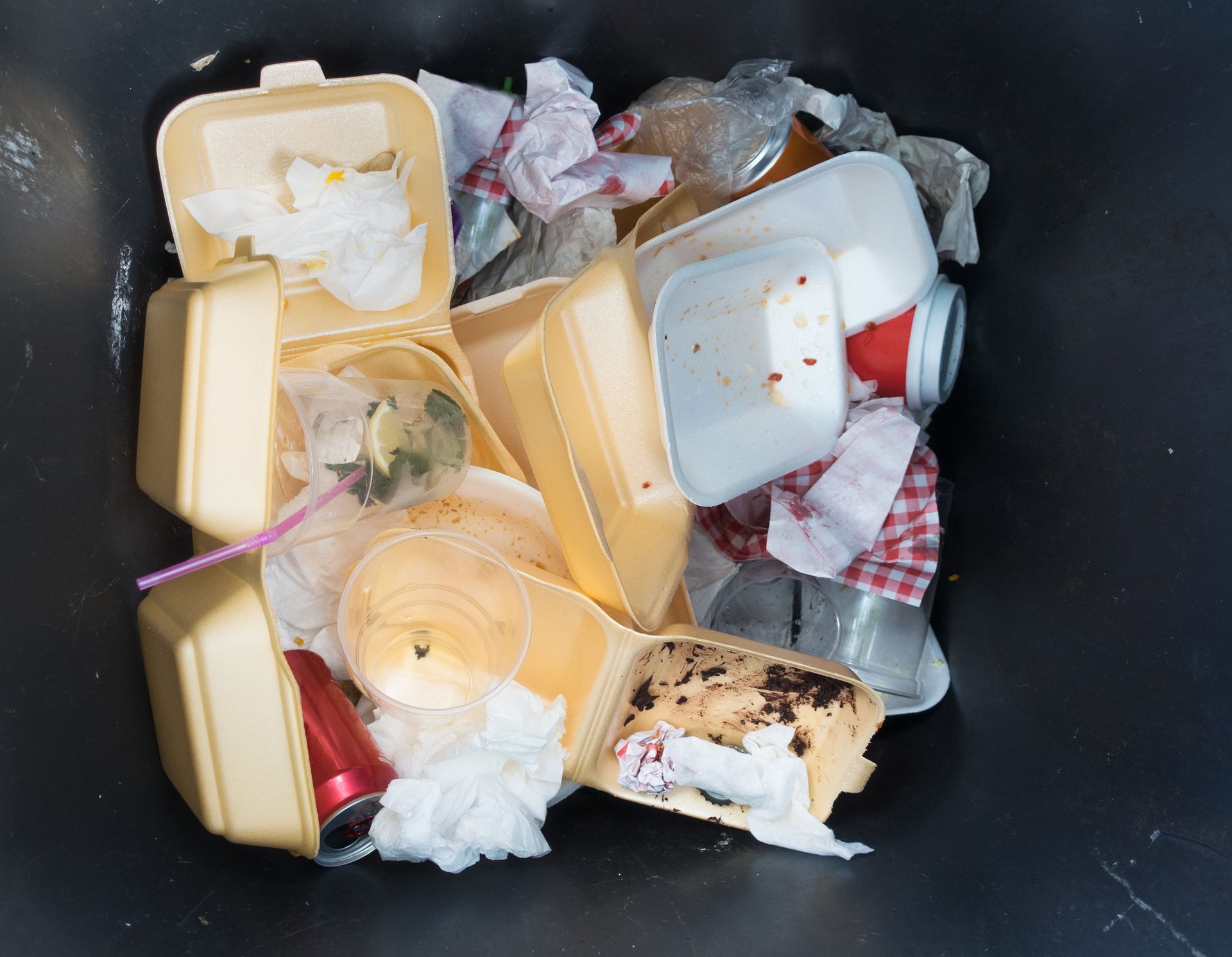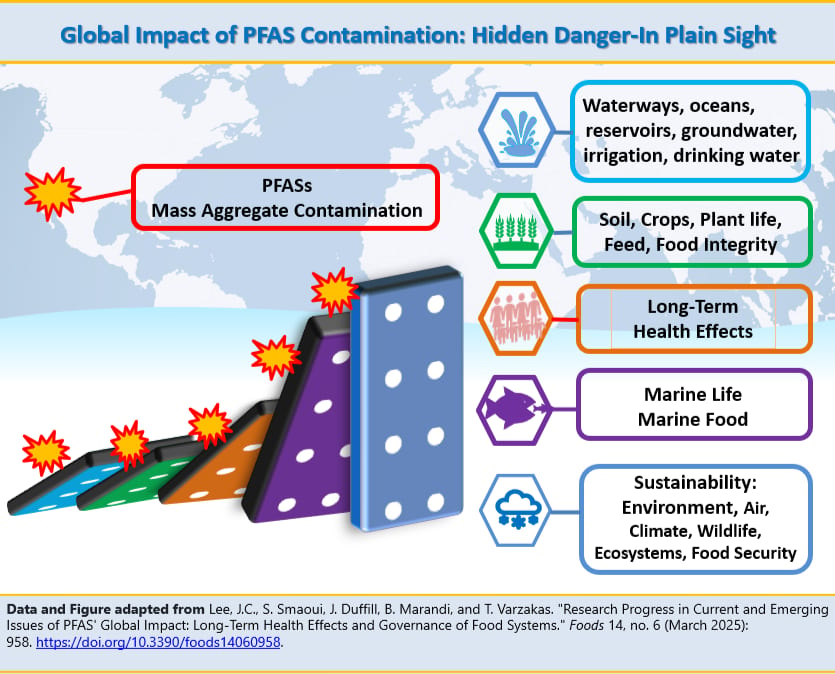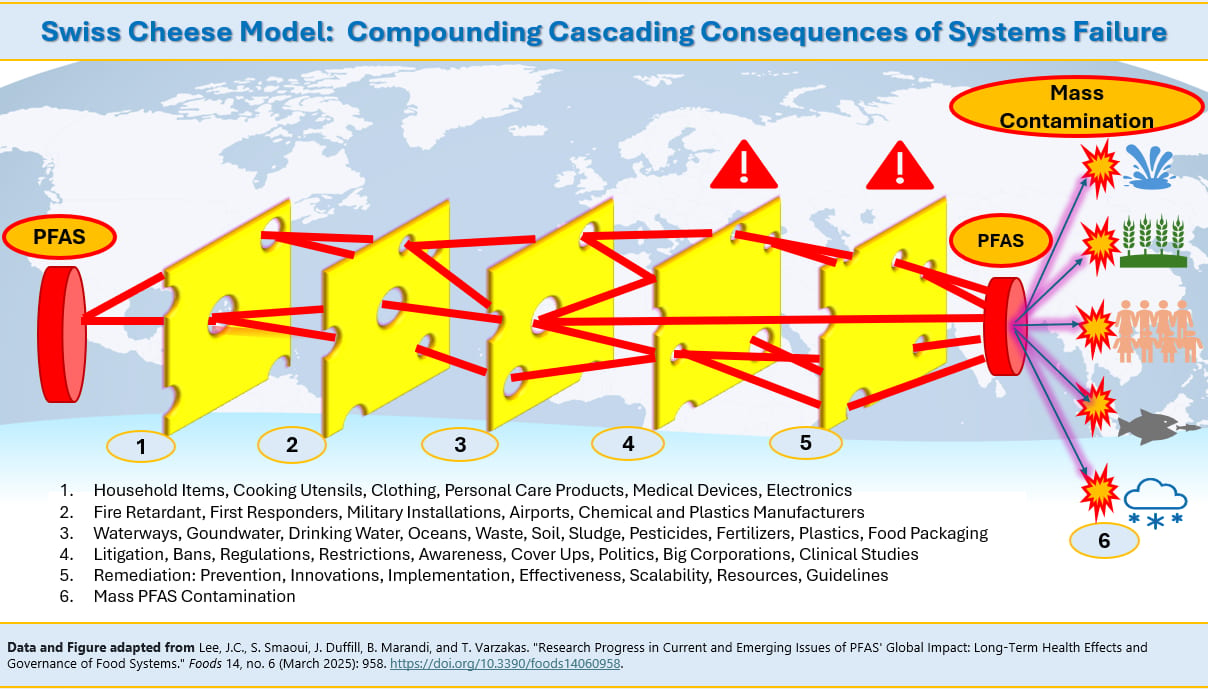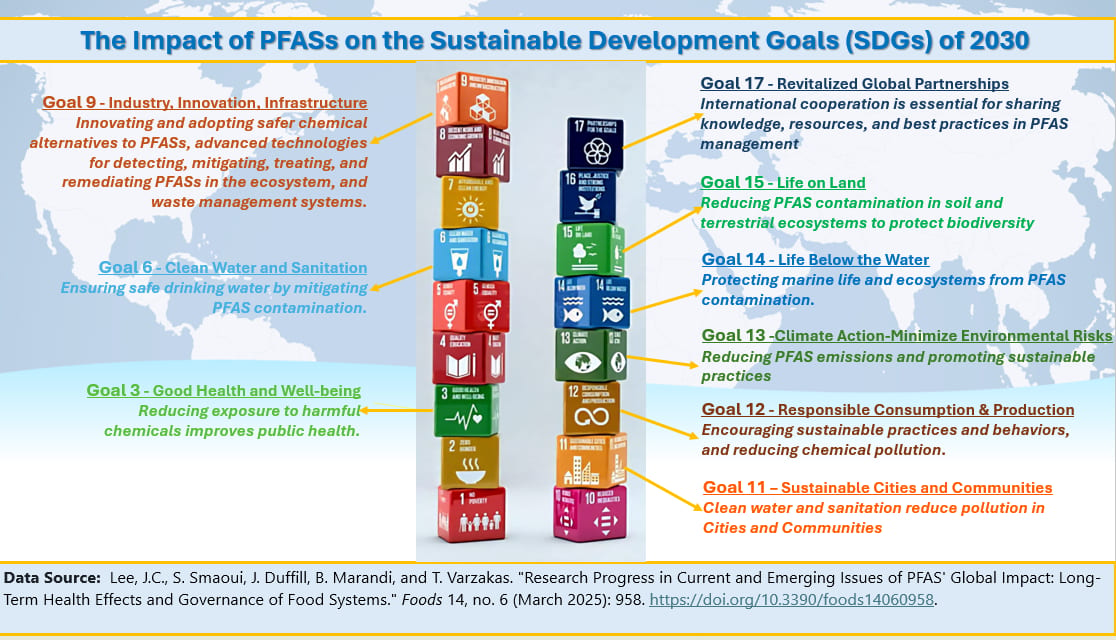PFAS
By Jocelyn C. Lee, Food Safety Consultant, Gourmet In Motion; Ben Marandi, Ph.D., Food Scientist, Researcher, and Food Policy and Legal Advisor; John Duffill, CEO, John Crop Development Vietnam; Slim Smaoui, Ph.D., Professor, Center of Biotechnology of Sfax; and Theodoros Varzakas, Ph.D., Professor, Department of Food Science and Technology, University of Peloponnese
Unmasking 'Forever Chemicals': Global Insights on PFAS and Urgent Calls to Action—Part 2
In analyzing the PFAS crisis, it is necessary to identify system failures and their resulting health impacts

Image credit: georgeclerk/iStock/Getty Images Plus via Getty Images
SCROLL DOWN
Part 2 of this article series discusses the application of several problem-solving analytical tools to the PFAS crisis, as well as the impacts of per- and polyfluoroalkyl substances (PFAS) on the United Nations' Sustainable Development Goals (SDGs) for 2030.
Systems failure analysis involves looking at accidents within the context of the entire system, rather than just focusing on individual components or human error. This method considers technical, human, and environmental interactions.1 Models such as the Domino Effect, Swiss Cheese Theory, and Ishikawa Fishbone Root Cause Analysis are employed to detect systemic problems and enhance safety.2,3,4
The Domino Effect Model, introduced by Herbert W. Heinrich, depicts a failure sequence as a chain of events, like a row of dominos falling in succession. The first domino's collapse triggers the second's fall, followed by the third, and so forth. This model underscores that a single cause is insufficient to explain why a failure occurred. Instead, it emphasizes the need to address multiple factors to prevent failures.2
The Domino Effect Model (Figure 1) illustrates how a sequence of interconnected events or failures can culminate in a significant, catastrophic outcome. In the context of the PFAS crisis, the widespread use of these chemicals in various products, coupled with insufficient regulation and oversight, has triggered a chain reaction of contamination and health hazards. The release of PFAS compounds into the environment has led to their accumulation in water sources, soil, and food supplies, resulting in extensive exposure and long-term health impacts for humans and wildlife.5,6
FIGURE 1. The Domino Effect Model: Global Impact of PFAS Contamination2,5,6,7 (Image credit: Jocelyn C. Lee, John Duffill, Ben Marandi, Slim Smaoui, and Theodoros Varzakas)

The Swiss Cheese Model, developed by James Reason, portrays how failures often stem from a combination of factors rather than a single root cause. It compares human systems to multiple slices of Swiss cheese, each with holes representing weaknesses. When these holes align, a hazard can pass through all layers, leading to failure. This model highlights the importance of having multiple layers of defense to prevent accidents.3 In the context of the PFAS crisis, regulatory shortcomings, industry practices, and gaps in public awareness have all contributed to the persistence of PFAS contamination. The absence of comprehensive regulations, ethical lapses by chemical companies, and potential cover-ups have allowed the problem to escalate and affect communities globally8 (Figure 2).
FIGURE 2. The Swiss Cheese Model: Compounding Cascading Consequences of Systems Failure3,7,8 (Image credit: Jocelyn C. Lee, John Duffill, Ben Marandi, Slim Smaoui, and Theodoros Varzakas)

Fishbone Root Cause Analysis, also known as the Ishikawa Diagram, is a visual tool used to identify the root causes of a problem. The main problem is placed at the "head" of the fish, and potential causes are categorized into branches, such as Methods, Machines, People, Materials, Measurements, and Environment. This method helps teams systematically explore and address the underlying issues.9
Ishikawa Fishbone Root Cause Analysis is a tool that visually maps probable contributing components to discover the root cause of an issue. In the context of the PFAS crisis, this method can be particularly useful for understanding the complex factors that have led to widespread PFAS contamination.10
By systematically breaking down the problem and identifying contributing factors, Ishikawa Fishbone Root Cause Analysis helps stakeholders develop targeted and effective solutions to address the PFAS crisis.9 The central issue or problem is the presence of PFAS in the environment, particularly in water sources.11 On the Fishbone Diagram, the horizontal line (the "spine") represents the problem of PFAS contamination. Branching off this line are major categories of potential causes, "Human Activities," "Management," "Sites and Equipment," "Materials," "Environment," and "Measurement" (Figure 3).12
FIGURE 3. Fishbone Root Cause Analysis for PFAS Contamination of Global Systems7,10,11,12 (Image credit: Jocelyn C. Lee, John Duffill, Ben Marandi, Slim Smaoui, and Theodoros Varzakas)

For each category, brainstorming of possible causes of PFAS contamination has been carried out regarding which materials and certain types of PFAS are used in existing products:13
- Sites and equipment (methods) refer to industrial processes that release PFAS14 and equipment that may contribute to PFAS release.15
- Measurement refers to the inadequate monitoring of PFAS levels.11
- Human activities contributing to PFAS spread correspond to people.16
- Natural factors affecting PFAS distribution17 have to do with the environment.
- Policies and practices that may have allowed PFAS use15 relate to their management. Waste mismanagement refers to the improper disposal and management of PFAS-containing waste.18
It is essential to analyze and prioritize potential causes by assessing their likelihood of contributing to the issue. Prioritization will be based on the impact of these causes and the feasibility of addressing them.12
With these root causes identified, the next step is to develop targeted strategies for mitigation. Based on this analysis, strategies will be developed to address and resolve the root causes of PFAS contamination. The following solutions are proposed:
- Develop and promote the use of safer alternative substances to replace PFAS in products.14
- Implement stricter regulations and best practices for industries to reduce PFAS emissions during manufacturing processes.11
- Upgrade industrial equipment to prevent PFAS leakage and enhance the efficiency of PFAS capture technologies.19
- Establish comprehensive monitoring programs to regularly assess PFAS levels in the environment and identify contamination hotspots.16
- Increase public awareness and education on the sources and impacts of PFAS, encouraging responsible consumer behavior.13
- Implement remediation and cleanup efforts in contaminated areas, using advanced techniques like adsorption and filtration.14
- Strengthen policies and international agreements to phase out the manufacturing and use of PFAS internationally (UN SDG Goal 17).15
- Improve waste management practices to ensure the proper disposal and treatment of PFAS-containing waste, reducing environmental contamination.20
- Implement bioremediation efforts. Bioremediation, an economical and environmentally friendly technique, can play a significant role in achieving the UN SDGs by 2030. Bioremediation costs vary, but they are generally lower than traditional remediation methods, with estimates ranging from USD $50.7–$310.4 per m3 of contaminated soil.21
- Implement bioremediation to help achieve the SDGs related to clean water and sanitation (Goal 6), sustainable cities and communities (Goal 11), and life below water (Goal 14) by reducing pollution and promoting environmental sustainability (Goal 13).22,23
TABLE 1. Fake Internet Domains Registered as Part of Typosquatting Campaign
“By understanding the systemic nature of failures, identifying root causes, and applying structured problem-solving methods, organizations can improve their safety, efficiency, and overall performance.”


In addressing the PFAS crisis, potential bioremediation solutions, such as utilizing microorganisms to degrade PFAS compounds, present a promising approach to mitigate contamination and reduce long-term health risks. However, additional research and regulatory measures are necessary to ensure the efficacy and safety of these remediation methods.
By applying the Domino Effect Model and Swiss Cheese Model to the PFAS crisis, we can gain a deeper understanding of the complex interplay of factors that have contributed to this significant system failure and work toward implementing comprehensive solutions to protect public health and the environment. Combining the Domino Effect Model, the Swiss Cheese Model, and the Fishbone Root Cause Analysis Model can significantly enhance an organization's ability to detect and successfully resolve issues. By understanding the systemic nature of failures, identifying root causes, and applying structured problem-solving methods, organizations can improve their safety, efficiency, and overall performance.
Impact of PFAS on the UN SDGs for 2030
Addressing the PFAS crisis aligns with several SDGs, including Goals 3, 6, 9, 12, 13, 14, 15, and 17.
FIGURE 4. The Impact of PFAS on the Sustainable Development Goals of 20307,15,21–28 (Image credit: Jocelyn C. Lee, John Duffill, Ben Marandi, Slim Smaoui, and Theodoros Varzakas)

Goals and PFAS mitigation alignment details follow:
- Goal 3: Good Health and Well-Being: Reducing exposure to harmful chemicals improves public health. The U.S. Centers for Disease Control and Prevention (CDC) and the U.S. Agency for Toxic Substances and Disease Registry (ATSDR) have conducted exposure assessments to determine the impact of PFAS on health.24
- Goal 6: Clean Water and Sanitation: We need to ensure safe drinking water by mitigating PFAS contamination. The U.S. Environmental Protection Agency (EPA) has set the first national drinking water guidelines for PFAS to safeguard communities from exposure.25
- Goal 9: Industry, Innovation, and Infrastructure: Industries must innovate and adopt safer chemical alternatives to PFAS. This involves investing in research and development to create nontoxic substitutes that can perform similar functions without harming the environment. Additionally, infrastructure projects should incorporate advanced technologies for detecting and mitigating PFAS contamination in water, soil, and air. By fostering innovation in chemical management and infrastructure development, we can reduce the environmental footprint of PFAS and promote sustainable industrialization.23,26
- Goal 11: Sustainable Cities and Communities: Implementing bioremediation can help achieve the SDGs related to clean water and sanitation by reducing pollution and promoting environmental sustainability in cities and communities.22,23
- Goal 12: Responsible Consumption and Production: This goal concerns sustainable practices and behaviors to reduce chemical pollution. EPA has been investing in projects to address PFAS contamination in water through the U.S. Bipartisan Infrastructure Law.27
- Goal 13: Climate Action: It is essential to implement stricter regulations and policies to reduce PFAS emissions and promote sustainable practices. This includes investing in research and development to create safer chemical alternatives that do not contribute to environmental pollution. Additionally, continuous monitoring and remediation efforts are necessary to mitigate the impact of PFAS on the environment. International cooperation and partnerships are vital for addressing PFAS contamination and achieving climate action goals. Organizations like the Organization for Economic Cooperation and Development (OECD) and the Waterkeeper Alliance play a crucial role in facilitating global collaboration to tackle PFAS pollution. By working together, we can enhance our collective capacity to manage PFAS effectively and move toward a healthier, more sustainable future.28
- Goal 14: Life Below Water: We need to protect marine life and ecosystems from PFAS contamination. The Waterkeeper Alliance has been working to monitor and remediate PFAS pollution in global waterways.23
- Goal 15: Life on Land: Reducing PFAS contamination in soil and terrestrial ecosystems to protect biodiversity is vital. The OECD has hosted forums to address the environmental impact of PFAS.28
- Goal 17: Partnerships for the Goals: Addressing the PFAS crisis necessitates collaboration among governments, industries, research institutions, and civil society organizations. International cooperation is crucial for sharing knowledge, resources, and best practices in PFAS management. Organizations such as the OECD and the Waterkeeper Alliance are instrumental in fostering partnerships to combat PFAS contamination. The OECD organizes forums to discuss the environmental impact of PFAS, while the Waterkeeper Alliance focuses on monitoring and remediating PFAS pollution in global waterways. By strengthening partnerships and promoting collaboration, we can enhance our collective ability to manage PFAS more effectively.28
PFAS contamination affects water, soil, and air, posing risks to food security and nutrition. These persistent chemicals complicate cleanup efforts due to their slow degradation and widespread presence.30 Researchers are exploring bioremediation techniques, such as using microbes and plants like birch and willow trees, to absorb and break down PFAS compounds.31
The future of PFAS management requires a multifaceted approach. This includes stricter regulations, investment in safer chemical alternatives, continuous monitoring and research, and public awareness about PFAS in consumer products. Sustainable manufacturing and waste management practices are necessary to mitigate these chemicals' environmental footprint.11,32
PFAS remains a significant public health issue, driving continuous research and regulatory efforts. CDC plays a crucial role in examining the health impacts of PFAS, advising on mitigation and prevention strategies, and supporting regulatory frameworks to safeguard communities from these persistent pollutants.33 Ongoing monitoring and community involvement are essential for effective PFAS management.25,34,35
While SDG alignment emphasizes global priorities, practical action is needed at the local and industry levels.
“The use of PFAS in plastics, such as food packaging, has contributed to their widespread environmental distribution. Discarding or incinerating these plastics releases PFAS compounds into the air, water, and soil, causing contamination.”


How Waste Mismanagement Contributes to the PFAS Crisis
The PFAS crisis is a multifaceted issue aggravated by the mismanagement of waste, particularly in wastewater treatment, landfills, and plastic production. The presence of PFAS chemicals in these areas has led to the contamination of water supplies and soil, posing risks to aquatic life and human health.
Additionally, the use of PFAS in plastics has contributed to their spread in the environment, further impacting marine life and ecosystems. Wastewater treatment plants and landfills are significant sources of PFAS contamination, resulting in the accumulation of these harmful chemicals in aquatic ecosystems.
Studies have shown that wastewater treatment plants are a significant source of PFAS contamination in water bodies. The persistence of these chemicals in wastewater effluents can lead to their accumulation in rivers, lakes, and oceans, posing risks and hazards to aquatic life and human health. Landfills also play an impactful role in the release of PFAS compounds into the environment, as leachate from landfills can contain high levels of these chemicals, contaminating groundwater and soil.
The use of PFAS in plastics, such as food packaging, has contributed to their widespread environmental distribution. Discarding or incinerating these plastics releases PFAS compounds into the air, water, and soil, causing contamination.
The presence of PFAS compounds in water bodies harms marine life and aquatic ecosystems. PFAS accumulate in fish and other organisms, posing health risks to wildlife and humans that consume contaminated seafood. Additionally, PFAS contamination disrupts ecosystems, impacting biodiversity and ecosystem health.7
Conclusion
This crisis, when examined through systemic models such as the Swiss Cheese Theory, the Domino Effect Model, and Fishbone Root Cause Analysis, highlights not only the persistence of harmful chemicals but also significant failures in governance and oversight. Immediate global coordination is needed to address these issues effectively.
The mismanagement of waste, including plastics and wastewater, has greatly contributed to the PFAS crisis, causing significant environmental harm. Effective regulations, better waste management practices, and sustainable alternatives to PFAS are essential for addressing these issues. Collaboration among governments, researchers, and environmental organizations is crucial to mitigating PFAS impacts on public health.
PFAS at high levels pose serious health risks, making it important to remove them from the environment when feasible. A recent cost-benefit study supports cleanup efforts, particularly for contaminated drinking water. The U.S. EPA's PFAS Strategic Roadmap focuses on reducing emissions, improving detection, and accelerating site cleanups to tackle these concerns.
One promising research area is the use of plants in bioremediation to address PFAS contamination, with certain species capable of effectively absorbing and degrading these compounds, thus providing a sustainable and cost-effective solution. The C8 Science Panel's findings on PFOA exposure highlight the urgent need for strict regulations and consistent monitoring to safeguard public health. As the global PFAS presence increases, we must rethink our approach; focusing on enhanced remediation efforts and reduced emissions is essential. This review assesses the potential costs of relying solely on remediation, estimating that ongoing PFAS removal could reach annual costs between USD $20 trillion and $7,000 trillion. Without significant cuts in production and emissions, these costs could surpass the world GDP of USD $106 trillion, rendering pure remediation impractical.
The primary method for addressing the accumulation of PFAS in the environment is to change the mass balance by reducing emissions, increasing the removal of these substances, or both. Integrating sustainable practices into food systems is essential for fostering a healthy planet. Sustainable food systems can help reduce PFAS contamination by encouraging eco-friendly agricultural practices and minimizing the use of harmful chemicals. This approach addresses current environmental challenges while also promoting long-term food security and public health. This review contributes to the ongoing discussion on PFAS policy by placing greater emphasis on remediation strategies.7
Notes
- The data referred to in this article was obtained using private sector analytical services and databases made available to the authors. The authors sincerely thank those responsible for the analysis.
- Data obtained from private sector sources.
References
- Leveson, N. Engineering a Safer World: Systems Thinking Applied to Safety. MIT Press, 2011. https://direct.mit.edu/books/oa-monograph/2908/Engineering-a-Safer-WorldSystems-Thinking-Applied.
- Heinrich, H.W. Industrial Accident Prevention: A Scientific Approach. McGraw-Hill, 1941. https://archive.org/details/dli.ernet.14601.
- Reason, J. Human Error. Cambridge University Press, 1990. https://www.cambridge.org/highereducation/books/human-error/281486994DE4704203A514F7B7D826C0.
- Ishikawa, K. Guide to Quality Control. Asian Productivity Organization, 1968. https://books.google.com/books/about/Guide_to_Quality_Control.html?id=POEeAQAAIAAJ.
- Birnbaum, L.S. "The impact of environmental chemicals on human health." Fertility and Sterility 89, no. 2: E31 (February 2008): https://www.fertstert.org/article/S0015-0282(07)04301-4/fulltext.
- Dehghani, M.H., M. Aghaei, P. Bashardoust, et al. "An insight into the environmental and human health impacts of per- and polyfluoroalkyl substances (PFAS): Exploring exposure pathways and their implications." Environmental Sciences Europe 37, no. 81 (2025). https://doi.org/10.1186/s12302-025-01122-9.
- Lee, J.C., S. Smaoui, J. Duffill, B. Marandi, and T. Varzakas. "Research Progress in Current and Emerging Issues of PFASs' Global Impact: Long-Term Health Effects and Governance of Food Systems." Foods 14, no. 6 (March 2025): 958. https://doi.org/10.3390/foods14060958.
- Shabani, T., S. Jerie, and T. Shabani. "A Comprehensive Review of the Swiss Cheese Model in Risk Management." Safety in Extreme Environments 6 (2023): 43–57. https://link.springer.com/article/10.1007/s42797-023-00091-7.
- Tague, N.R. The Quality Toolbox. 3rd Ed. ASQ, 2024. https://asq.org/quality-press/display-item?item=H1592&srsltid=AfmBOoqQaFfU7NO5wYgWu6PSu0gvnb0mth1BkVkc_IrD_7URfxt5QYiy.
- Ishikawa, K. Guide to Quality Control. Asian Productivity Organization, 1968. https://books.google.com/books/about/Guide_to_Quality_Control.html?id=POEeAQAAIAAJ.
- U.S. Environmental Protection Agency (EPA). "Per- and Polyfluoroalkyl Substances (PFAS) in Wastewater." 2021. https://www.epa.gov/pfas.
- Tague, N.R. The Quality Toolbox. 3rd Ed. ASQ, 2024. https://asq.org/quality-press/display-item?item=H1592&srsltid=AfmBOoqQaFfU7NO5wYgWu6PSu0gvnb0mth1BkVkc_IrD_7URfxt5QYiy.
- Buck, R.C., J. Franklin, U. Berger, et al. "Perfluoroalkyl and polyfluoroalkyl substances in the environment: Terminology, classification, and origins." Integrated Environmental Assessment and Management 7 (2011): 513–541. https://academic.oup.com/ieam/article-abstract/7/4/513/7741313.
- Jones, L. and M. Brown. "The PFAS and Microplastics Nexus: Implications for Public Health and Environmental Policy." Journal of Environmental Management 278 (2021): 111–120.
- Lindstrom, A.B., M.J. Strynar, and E.L. Libelo. "Polyfluorinated compounds: Past, present, and future." Environmental Science & Technology Journal 45 (2011): 7954–7961. https://pubs.acs.org/doi/10.1021/es2011622.
- Lau, C., K. Anitole, C. Hodes, D. Lai, A. Pfahles-Hutchens, and J. Seed. "Perfluoroalkyl acids: A review of monitoring and toxicological findings." Toxicological Sciences 99 (2007): 366–394. https://academic.oup.com/toxsci/article-abstract/99/2/366/1679065?redirectedFrom=fulltext.
- U.S. Environmental Protection Association (EPA). "Our Current Understanding of the Human Health and Environmental Risks of PFAS." Last updated November 26, 2024. https://www.epa.gov/pfas/our-current-understanding-human-health-and-environmental-risks-pfas.
- European Commission. EU Science Hub. "Less Than One-Fifth of EU Plastic Was Recycled in 2019, but 2025 Targets Can Be Still Reached." January 25, 2024. https://joint-research-centre.ec.europa.eu/jrc-news-and-updates/less-one-fifth-eu-plastic-was-recycled-2019-2025-targets-can-be-still-reached-2024-01-25_en.
- Newton, S., R. McMahen, J. Stoeckel, M. Chislock, A. Lindstrom, and M. Strynar. "Novel polyfluorinated compounds identified using high resolution mass spectrometry downstream manufacturing facilities near Decatur, Alabama." Environmental Science & Technology 51 (2020): 1544–1552. https://pubs.acs.org/doi/10.1021/acs.est.6b05330.
- Global Environment Facility (GEF). https://www.thegef.org/.
- Orellana, R., A. Cumsille, P. Piña-Gangas, et al. "Economic Evaluation of Bioremediation of Hydrocarbon-Contaminated Urban Soils in Chile." Sustainability 14 (2022): 11854. https://www.mdpi.com/2071-1050/14/19/11854.
- Shah, M.P., Ed. Sustainable Industrial Wastewater Treatment and Pollution Control. Springer, 2023. https://link.springer.com/book/10.1007/978-981-99-2560-5.
- Waterkeeper Alliance. "Empowering Communities and Spurring Governmental Action to Stop and Clean Up PFAS Pollution." 2024. https://sdgs.un.org/partnerships/empowering-communities-and-spurring-governmental-action-stop-and-clean-pfas-pollution.
- U.S. Agency for Toxic Substances and Disease Registry (ATSDR). "Per- and Polyfluoroalkyl Substances (PFAS) and Your Health." https://www.atsdr.cdc.gov/pfas/index.html.
- EPA. "Fact Sheet Treatment Options from Drinking Water." April 2024. https://www.epa.gov/system/files/documents/2024-04/pfas-npdwr_fact-sheet_treatment_4.8.24.pdf.
- ATSDR. "PFAS Exposure Assessments." November 12, 2024. https://www.atsdr.cdc.gov/pfas/exposure-assessments/index.html.
- U.S. Food and Drug Administration (FDA). "Per- and Polyfluoroalkyl Substances (PFAS)." Content current as of January 3, 2025. https://www.fda.gov/food/environmental-contaminants-food/and-polyfluoroalkyl-substances-pfas.
- Global Forum on the Environment Dedicated to Per- and Polyfluoroalkyl Substances (PFAS). 2024. Available online: https://www.oecd.org/en/events/2024/02/global-forum-environment-per-and-polyfluoroalkyl-substances.html.
- EPA. "Per- and Polyfluoroalkyl Substances (PFAS): Final PFAS National Primary Drinking Water Regulation." https://www.epa.gov/sdwa/and-polyfluoroalkyl-substances-pfas.
- Amstutz, V.H., A. Cengo, F. Gehres, D.T.H.M. Sijm, and M.F. Vrolijk. "Investigating the cytotoxicity of per- and polyfluoroalkyl substances in HepG2 cells: A structure-activity relationship approach." Toxicology 480 (2022): 153312. https://www.sciencedirect.com/science/article/pii/S0300483X22002244?via%3Dihub.
- C8 Science Panel. http://www.c8sciencepanel.org/index.html.
- Li, J., J. Sun, and P. Li. "Exposure routes, bioaccumulation and toxic effects of per- and polyfluoroalkyl substances (PFASs) on plants: A critical review." Environment International 158 (2022): 106891. https://www.sciencedirect.com/science/article/pii/S016041202100516X?via%3Dihub.
- Safta, D. "Per- and Polyfluorinated Substances (PFAS); a Literature Review." Undergraduate Journal of Public Health 8 (2024): 6064. https://journals.publishing.umich.edu/ujph/article/id/6064/.
- U.S. Centers for Disease Control and Prevention (CDC). "Human Exposure: PFAS Information for Clinicians—2024." November 12, 2024. https://www.atsdr.cdc.gov/pfas/hcp/clinical-overview/human-exposure.html.
- EPA. "Key EPA Actions to Address PFAS." Last updated January 24, 2025. https://www.epa.gov/pfas/key-epa-actions-address-pfas.
Jocelyn C. Lee is Food Safety Consultant at Gourmet In Motion.
Ben Marandi, Ph.D. is a Food Scientist, Researcher, and Food Policy and Legal Advisor.
John Duffill is CEO of John Crop Development Vietnam.
Slim Smaoui, Ph.D. is a Professor at the Center of Biotechnology of Sfax.
Theodoros Varzakas, Ph.D. is a Professor in the Department of Food Science and Technology at the University of Peloponnese.

